Development and Characterization of a Time-Sequenced Cascade Impactor: Application to Transient PM2.5 Pollution Events in Urbanized and Industrialized Environments
Abstract
:1. Introduction
2. Description and Theoretical Considerations
2.1. Description of the TRAPS
2.2. Theoretical Calculations and TRAPS Design
3. Materials and Methods
3.1. Experimental Setups for Laboratory Experiments
3.2. Experimental Setup for Atmospheric Applications
3.3. Particle Analysis Using Electron Microscopy
4. Results and Discussion
4.1. Experimental Determination of the Cut-Off Diameters
4.2. Observation and Analysis of Collected Particles
4.2.1. Particles Bouncing Effects
4.2.2. Particle Deposition Patterns
4.3. Application to Fine-Particle Pollution Event Monitoring
5. Conclusions
Supplementary Materials
Author Contributions
Funding
Institutional Review Board Statement
Informed Consent Statement
Data Availability Statement
Acknowledgments
Conflicts of Interest
References
- WHO. WHO Global Air Quality Guidelines: Particulate Matter (PM2.5 and PM10), Ozone, Nitrogen Dioxide, Sulfur Dioxide and Carbon Monoxide; WHO: Geneva, Switzerland, 2021. [Google Scholar]
- Kim, K.-H.; Kabir, E.; Kabir, S. A Review on the Human Health Impact of Airborne Particulate Matter. Environ. Int. 2015, 74, 136–143. [Google Scholar] [CrossRef] [PubMed]
- Atkinson, R.W.; Mills, I.C.; Walton, H.A.; Anderson, H.R. Fine Particle Components and Health—A Systematic Review and Meta-Analysis of Epidemiological Time Series Studies of Daily Mortality and Hospital Admissions. J. Expo. Sci. Environ. Epidemiol. 2015, 25, 208–214. [Google Scholar] [CrossRef] [PubMed] [Green Version]
- Machaczka, O.; Jirik, V.; Brezinova, V.; Vrtkova, A.; Miturova, H.; Riedlova, P.; Dalecka, A.; Hermanova, B.; Slachtova, H.; Siemiatkowski, G.; et al. Evaluation of Fine and Ultrafine Particles Proportion in Airborne Dust in an Industrial Area. Int. J. Environ. Res. Public Health 2021, 18, 8915. [Google Scholar] [CrossRef] [PubMed]
- Seinfeld, J.H.; Pandis, S.N. Atmospheric Chemistry and Physics: From Air Pollution to Climate Change; John Wiley & Sons: Hoboken, NJ, USA, 2016. [Google Scholar]
- Reizer, M.; Calzolai, G.; Maciejewska, K.; Orza, J.A.G.; Carraresi, L.; Lucarelli, F.; Juda-Rezler, K. Measurement Report: Receptor Modeling for Source Identification of Urban Fine and Coarse Particulate Matter Using Hourly Elemental Composition. Atmos. Chem. Phys. 2021, 21, 14471–14492. [Google Scholar] [CrossRef]
- Rai, P.; Slowik, J.G.; Furger, M.; El Haddad, I.; Visser, S.; Tong, Y.; Singh, A.; Wehrle, G.; Kumar, V.; Tobler, A.K.; et al. Highly Time-Resolved Measurements of Element Concentrations in PM10 and PM2.5: Comparison of Delhi, Beijing, London, and Krakow. Atmos. Chem. Phys. 2021, 21, 717–730. [Google Scholar] [CrossRef]
- Marris, H.; Deboudt, K.; Augustin, P.; Flament, P.; Blond, F.; Fiani, E.; Fourmentin, M.; Delbarre, H. Fast Changes in Chemical Composition and Size Distribution of Fine Particles during the Near-Field Transport of Industrial Plumes. Sci. Total Environ. 2012, 427–428, 126–138. [Google Scholar] [CrossRef]
- Bzdek, B.R.; Pennington, M.R.; Johnston, M.V. Single Particle Chemical Analysis of Ambient Ultrafine Aerosol: A Review. J. Aerosol Sci. 2012, 52, 109–120. [Google Scholar] [CrossRef]
- Li, W.; Shao, L.; Zhang, D.; Ro, C.-U.; Hu, M.; Bi, X.; Geng, H.; Matsuki, A.; Niu, H.; Chen, J. A Review of Single Aerosol Particle Studies in the Atmosphere of East Asia: Morphology, Mixing State, Source, and Heterogeneous Reactions. J. Clean. Prod. 2016, 112, 1330–1349. [Google Scholar] [CrossRef]
- Bukowiecki, N.; Lienemann, P.; Zwicky, C.N.; Furger, M.; Richard, A.; Falkenberg, G.; Rickers, K.; Grolimund, D.; Borca, C.; Hill, M.; et al. X-Ray Fluorescence Spectrometry for High Throughput Analysis of Atmospheric Aerosol Samples: The Benefits of Synchrotron X-Rays. Spectrochim. Acta Part B At. Spectrosc. 2008, 63, 929–938. [Google Scholar] [CrossRef]
- Cahill, T.A.; Goodart, C.; Nelson, J.W.; Eldred, R.A.; Nasstrom, J.S.; Feeney, P.J. Design and Evaluation of the Drum Impactor; Proceedings of International Symposium on Particulate and Multi-Phase Processes; Ariman, T., Veziroglu, T.N., Eds.; Hemisphere Publishing Corporation: Washington, DC, USA, 1985; Volume 2, pp. 319–325. [Google Scholar]
- Raabe, O.G.; Braaten, D.A.; Axelbaum, R.L.; Teague, S.V.; Cahill, T.A. Calibration Studies of the Drum Impactor. J. Aerosol Sci. 1988, 19, 183–195. [Google Scholar] [CrossRef]
- Annegarn, H.J.; Cahill, T.A.; Sellschop, J.P.F.; Zucchiatti, A. Time Sequence Particulate Sampling and Nuclear Analysis. Phys. Scr. 1988, 37, 282–290. [Google Scholar] [CrossRef]
- Bukowiecki, N.; Richard, A.; Furger, M.; Weingartner, E.; Aguirre, M.; Huthwelker, T.; Lienemann, P.; Gehrig, R.; Baltensperger, U. Deposition Uniformity and Particle Size Distribution of Ambient Aerosol Collected with a Rotating Drum Impactor. Aerosol Sci. Technol. 2009, 43, 891–901. [Google Scholar] [CrossRef] [Green Version]
- D’Alessandro, A.; Nava, S.; Van Ham, R.; Adriaens, A.; Lucarelli, F.; Marcazzan, G.; Prati, P.; Valli, G.; Vecchi, R.; Zucchiatti, A. PIXE and ToF-SIMS Analysis of Streaker Samplers Filters. Nucl. Instrum. Methods Phys. Res. Sect. B Beam Interact. Mater. At. 2004, 222, 261–269. [Google Scholar] [CrossRef] [Green Version]
- Formenti, P.; Prati, P.; Zucchiatti, A.; Lucarelli, F.; Mandò, P.A. Aerosol Study in the Town of Genova with a PIXE Analysis. Nucl. Instrum. Methods Phys. Res. Sect. B Beam Interact. Mater. At. 1996, 113, 359–362. [Google Scholar] [CrossRef]
- Marple, V.A.; Rubow, K.L.; Behm, S.M. A Microorifice Uniform Deposit Impactor (MOUDI): Description, Calibration, and Use. Aerosol Sci. Technol. 1991, 14, 434–446. [Google Scholar] [CrossRef]
- Pui, D.Y.H.; Romay-Novas, F.; Liu, B.Y.H. Experimental Study of Particle Deposition in Bends of Circular Cross Section. Aerosol Sci. Technol. 1987, 7, 301–315. [Google Scholar] [CrossRef]
- Marple, V.A.; Willeke, K. Impactor Design. Atmos. Environ. 1976, 10, 891–896. [Google Scholar] [CrossRef]
- Baron, P.A. Description of an Aerosol Calculator. In Proceedings of the Seventh International Aerosol Conference, St. Paul, MN, USA, 10–15 September 2006; Biswas, P., Chen, D.R., Hering, S., Eds.; American Association for Aerosol Research: Mount Laurel, NJ, USA, 2006; p. 555. [Google Scholar]
- Stabile, L.; Trassierra, C.V.; Dell’Agli, G.; Buonanno, G. Ultrafine Particle Generation through Atomization Technique: The Influence of the Solution. Aerosol Air Qual. Res. 2013, 13, 1667–1677. [Google Scholar] [CrossRef] [Green Version]
- Brostrøm, A.; Kling, K.I.; Koponen, I.K.; Hougaard, K.S.; Kandler, K.; Mølhave, K. Improving the Foundation for Particulate Matter Risk Assessment by Individual Nanoparticle Statistics from Electron Microscopy Analysis. Sci. Rep. 2019, 9, 8093. [Google Scholar] [CrossRef] [Green Version]
- Demokritou, P.; Gupta, T.; Ferguson, S.; Koutrakis, P. Development and Laboratory Performance Evaluation of a Personal Cascade Impactor. J. Air Waste Manag. Assoc. 2002, 52, 1230–1237. [Google Scholar] [CrossRef] [Green Version]
- Gomes, L.; Bergametti, G.; Dulac, F.; Ezat, U. Assessing the Actual Size Distribution of Atmospheric Aerosols Collected with a Cascade Impactor. J. Aerosol Sci. 1990, 21, 47–59. [Google Scholar] [CrossRef]
- Hinds, W.C. Aerosol Technology: Properties, Behavior, and Measurement of Airborne Particles; John Wiley & Sons: Hoboken, NJ, USA, 1999; Volume 31, p. 464. ISBN 0-471-19410-7. [Google Scholar]
- Marple, V.A.; Liu, B.Y.H. Characteristics of Laminar Jet Impactors. Environ. Sci. Technol. 1974, 8, 648–654. [Google Scholar] [CrossRef]
- Choël, M.; Deboudt, K.; Flament, P. Development of Time-Resolved Description of Aerosol Properties at the Particle Scale During an Episode of Industrial Pollution Plume. Water Air Soil Pollut. 2010, 209, 93–107. [Google Scholar] [CrossRef]
- Arndt, J.; Healy, R.M.; Setyan, A.; Flament, P.; Deboudt, K.; Riffault, V.; Alleman, L.Y.; Mbengue, S.; Wenger, J.C. Characterization and Source Apportionment of Single Particles from Metalworking Activities. Environ. Pollut. 2021, 270, 116078. [Google Scholar] [CrossRef]
- Mbengue, S.; Alleman, L.Y.; Flament, P. Metal-Bearing Fine Particle Sources in a Coastal Industrialized Environment. Atmos. Res. 2017, 183, 202–211. [Google Scholar] [CrossRef]
- Setyan, A.; Flament, P.; Locoge, N.; Deboudt, K.; Riffault, V.; Alleman, L.Y.; Schoemaecker, C.; Arndt, J.; Augustin, P.; Healy, R.M.; et al. Investigation on the Near-Field Evolution of Industrial Plumes from Metalworking Activities. Sci. Total Environ. 2019, 668, 443–456. [Google Scholar] [CrossRef] [PubMed]
- Arndt, J.; Deboudt, K.; Anderson, A.; Blondel, A.; Eliet, S.; Flament, P.; Fourmentin, M.; Healy, R.M.; Savary, V.; Setyan, A.; et al. Scanning Electron Microscopy-Energy Dispersive X-Ray Spectrometry (SEM-EDX) and Aerosol Time-of-Flight Mass Spectrometry (ATOFMS) Single Particle Analysis of Metallurgy Plant Emissions. Environ. Pollut. 2016, 210, 9–17. [Google Scholar] [CrossRef] [PubMed]
- Young, G.; Jones, H.M.; Darbyshire, E.; Baustian, K.J.; McQuaid, J.B.; Bower, K.N.; Connolly, P.J.; Gallagher, M.W.; Choularton, T.W. Size-Segregated Compositional Analysis of Aerosol Particles Collected in the European Arctic during the ACCACIA Campaign. Atmos. Chem. Phys. 2016, 16, 4063–4079. [Google Scholar] [CrossRef] [Green Version]
- Beji, A.; Deboudt, K.; Khardi, S.; Muresan, B.; Flament, P.; Fourmentin, M.; Lumière, L. Non-Exhaust Particle Emissions under Various Driving Conditions: Implications for Sustainable Mobility. Transp. Res. Part Transp. Environ. 2020, 81, 102290. [Google Scholar] [CrossRef]

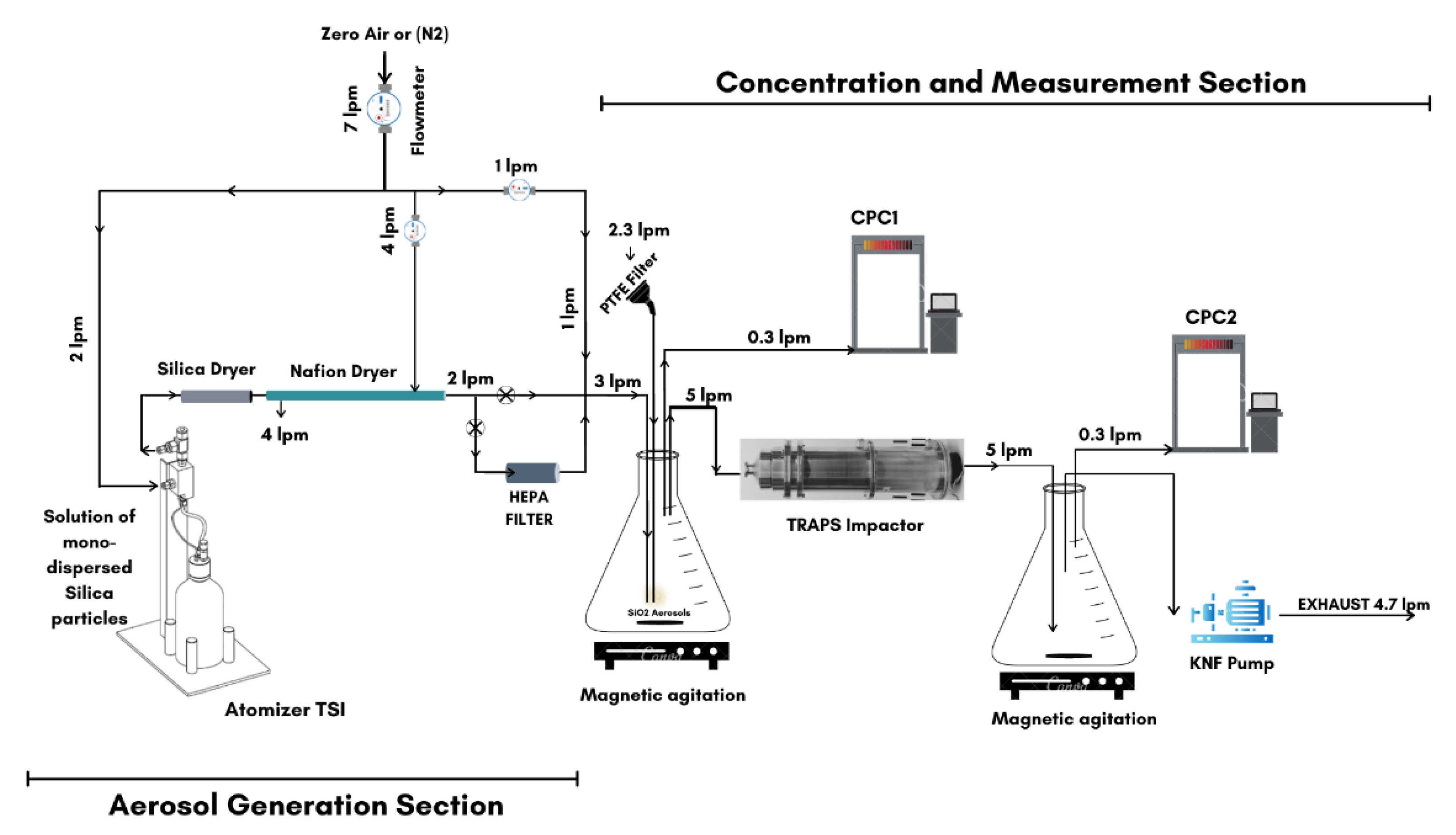
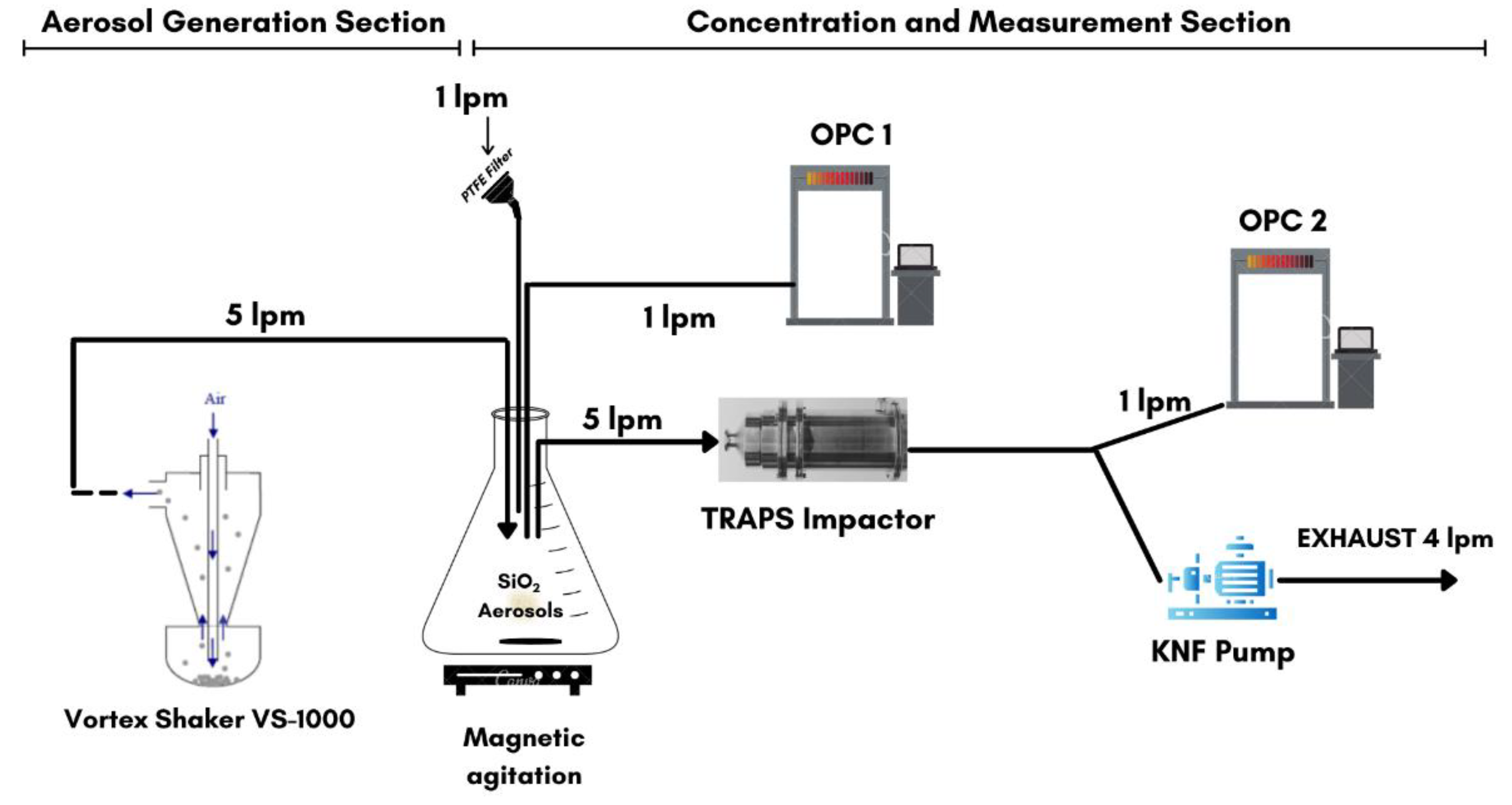
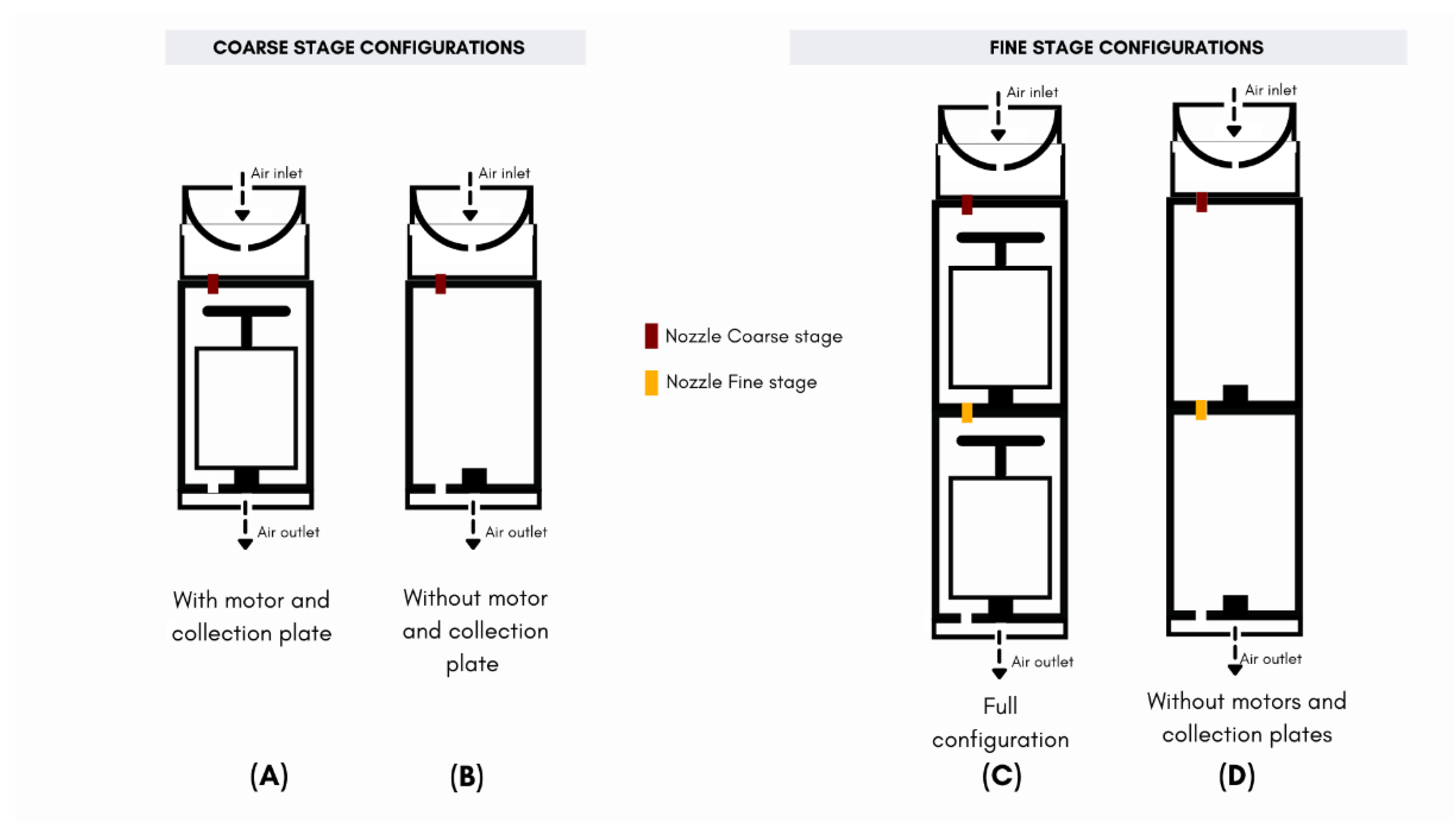
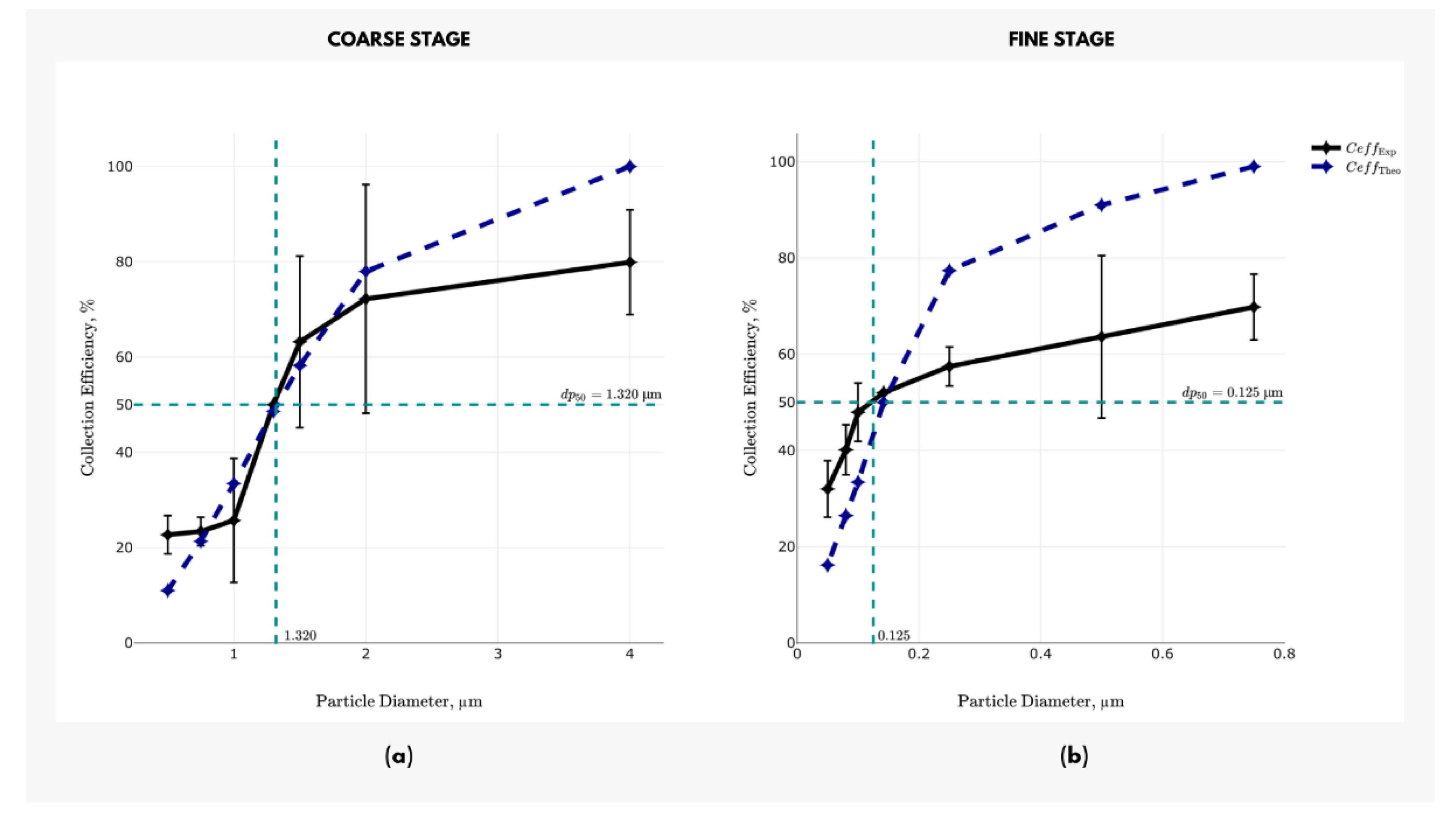
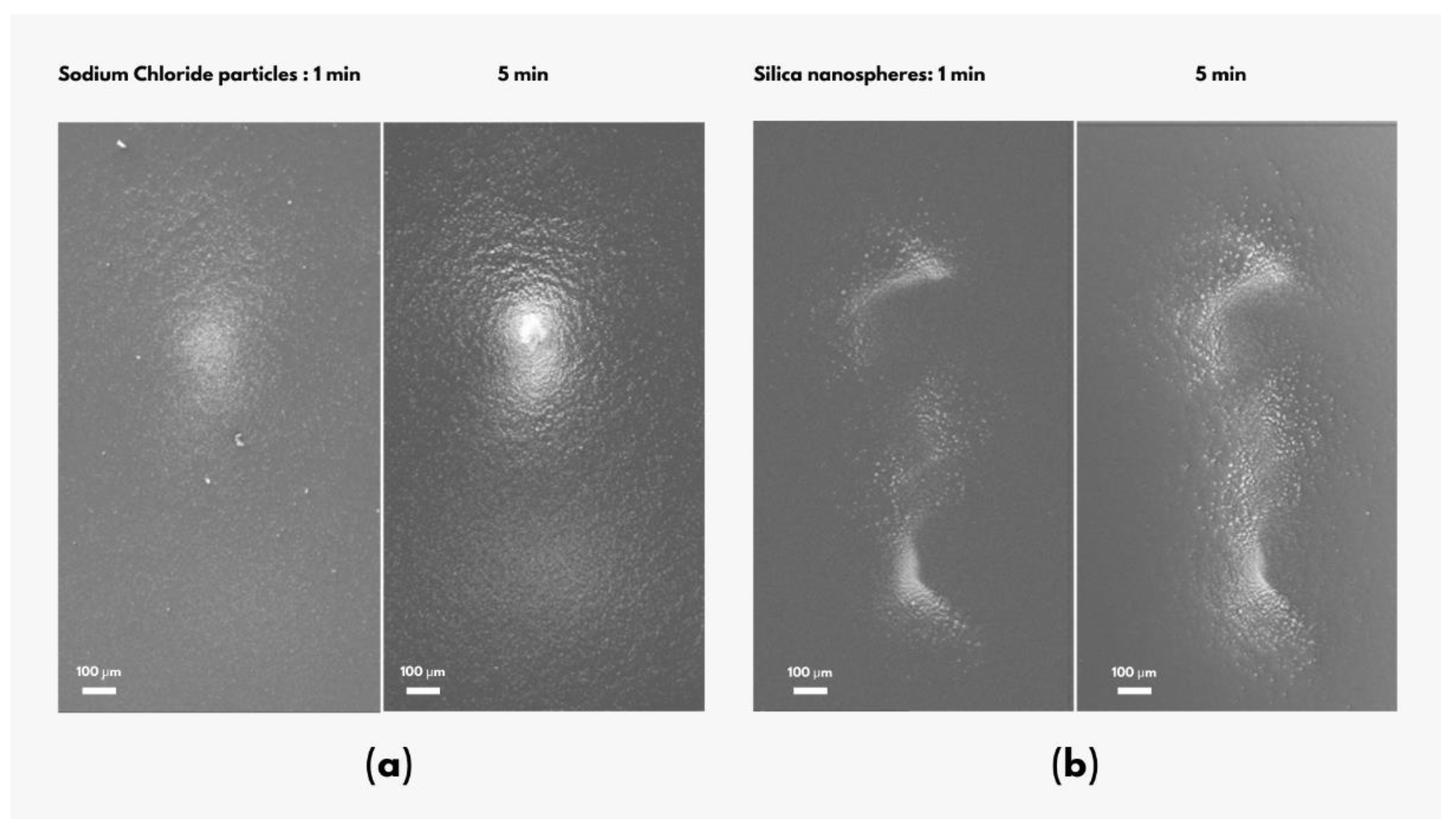
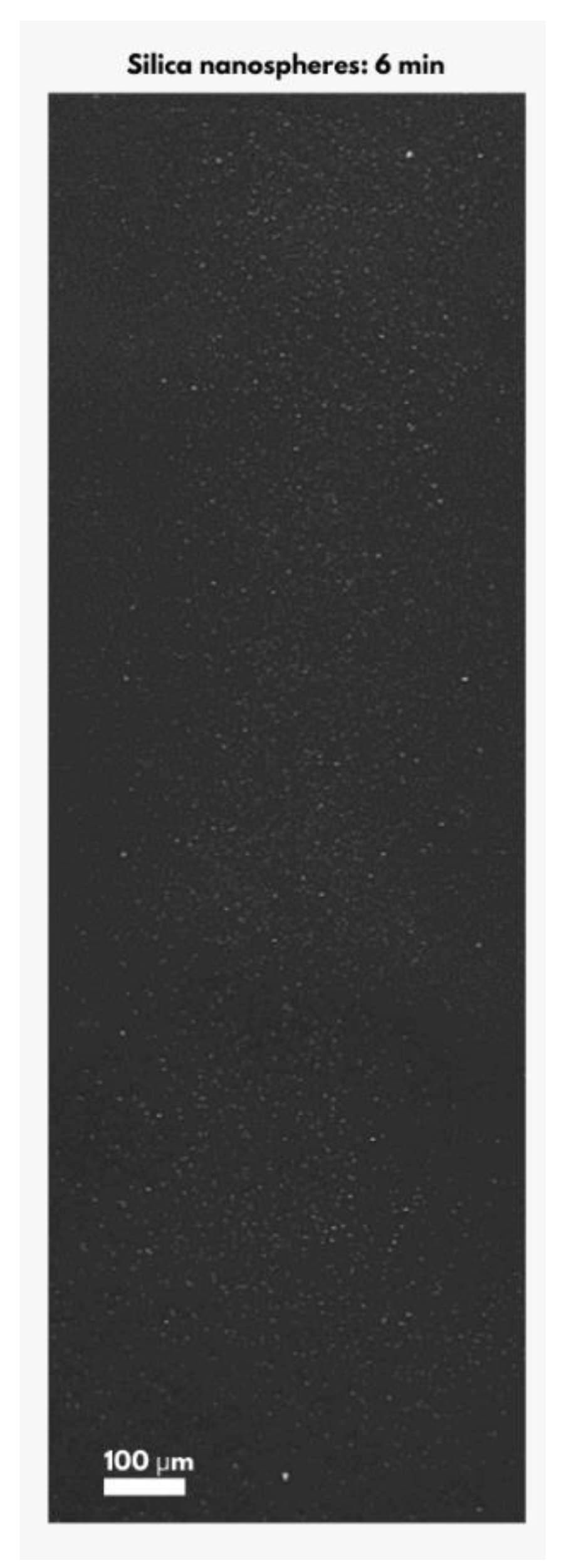


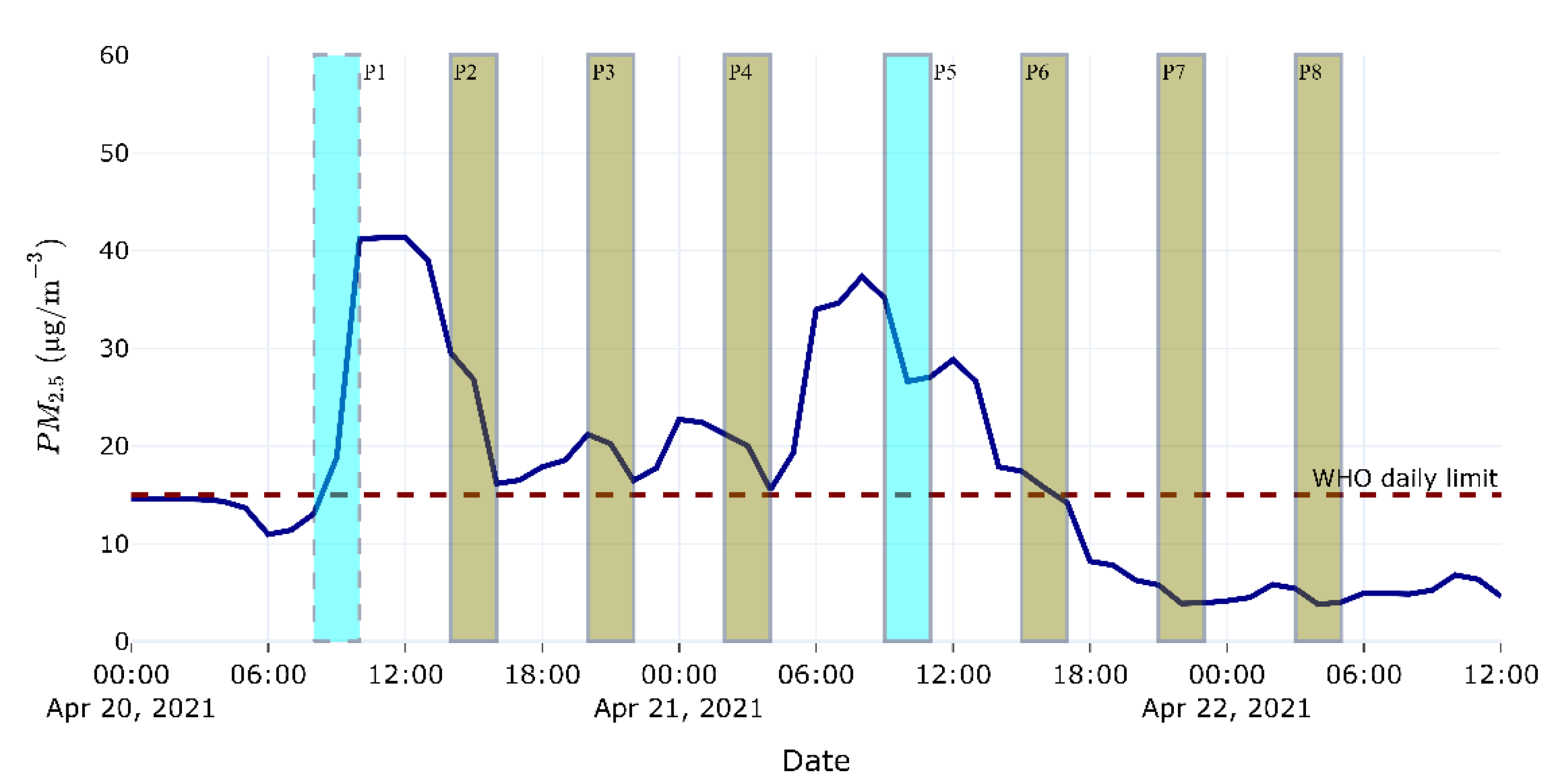

| Coarse Stage | Fine Stage | |
|---|---|---|
| Nozzle Equivalent Diameter (mm) | 1.940 | 0.564 |
| Cut-off diameter (µm) for ρp = 1.80 g·cm−3 | 1.30 | 0.15 |
| Air flow rate (L·m−1) | 5.00 | 5.00 |
| Air velocity inside the impaction nozzle (m·s−1) | 28 | 333 |
| Jet to plate distance ratio (S/W) | 2.56 | 5.32 |
| Nozzle Reynolds number | 3450 | 12,420 |
| Slip correction factor | 1.12 | 2.25 |
| Stokes number (Stk) | 0.30 | 0.31 |
Publisher’s Note: MDPI stays neutral with regard to jurisdictional claims in published maps and institutional affiliations. |
© 2022 by the authors. Licensee MDPI, Basel, Switzerland. This article is an open access article distributed under the terms and conditions of the Creative Commons Attribution (CC BY) license (https://creativecommons.org/licenses/by/4.0/).
Share and Cite
Ngagine, S.H.; Deboudt, K.; Flament, P.; Choël, M.; Kulinski, P.; Marteel, F. Development and Characterization of a Time-Sequenced Cascade Impactor: Application to Transient PM2.5 Pollution Events in Urbanized and Industrialized Environments. Atmosphere 2022, 13, 244. https://doi.org/10.3390/atmos13020244
Ngagine SH, Deboudt K, Flament P, Choël M, Kulinski P, Marteel F. Development and Characterization of a Time-Sequenced Cascade Impactor: Application to Transient PM2.5 Pollution Events in Urbanized and Industrialized Environments. Atmosphere. 2022; 13(2):244. https://doi.org/10.3390/atmos13020244
Chicago/Turabian StyleNgagine, Soulemane Halif, Karine Deboudt, Pascal Flament, Marie Choël, Pierre Kulinski, and Fabien Marteel. 2022. "Development and Characterization of a Time-Sequenced Cascade Impactor: Application to Transient PM2.5 Pollution Events in Urbanized and Industrialized Environments" Atmosphere 13, no. 2: 244. https://doi.org/10.3390/atmos13020244






